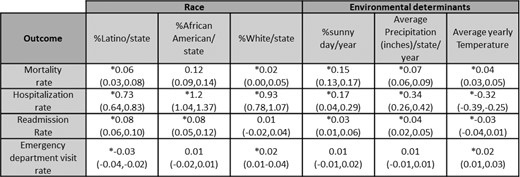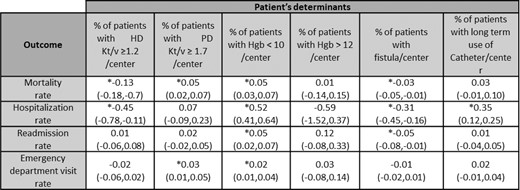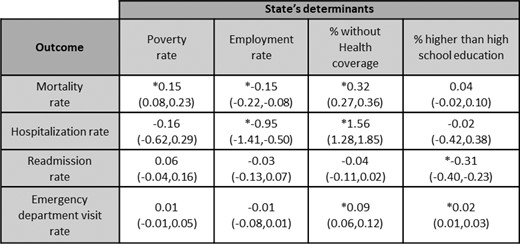-
PDF
- Split View
-
Views
-
Cite
Cite
Hassan Gorji, Xiaoling (Janice) Ye, #365 Dialysis centers performance: socioeconomic and environmental determinants, Nephrology Dialysis Transplantation, Volume 39, Issue Supplement_1, May 2024, gfae069–0166–365, https://doi.org/10.1093/ndt/gfae069.166
Close - Share Icon Share
Abstract
Healthcare outcomes in hemodialysis centers are intricately shaped by a myriad of factors extending beyond clinical realms. This study explores the interplay of socioeconomic and environmental determinants on the performance of 7638 hemodialysis centers in the United States during 2022. Leveraging data from the Centers for Medicare & Medicaid Services, the United States Census Bureau, and the National Center for Environmental Information, our analysis encompasses outcomes like mortality, hospitalization, readmission rates, and emergency department visit rates.
A dataset comprising information from 7638 US hemodialysis centers, spanning January to December 2022, was obtained through the Centers for Medicare & Medicaid Services, US Census Bureau and environmental data, and from the National Center for Environmental Information. The study assessed mortality, hospitalization, readmission, and emergency department visits within one-month post-hospitalization. Independent variables included dialysis center characteristics, state-specific socioeconomic and environmental data, analysed through descriptive statistics and a linear regression model.
Results reveal a significant correlation between racial composition and outcomes, with states having higher Latino populations exhibiting lower ED visit rates, contrasting with elevated mortality rates in states with higher African American populations. Socioeconomic factors, such as education and insurance status, influence ED visit rates. Environmental determinants, specifically average yearly state temperature, impact mortality and hospitalization rates. Operational characteristics matter: for-profit centres and those providing higher number of hemodialysis bed correlate with decreased mortality rates, while centres offering peritoneal dialysis or late-shift services demonstrate lower emergency department visit rates.
Our study unveils a nuanced interplay of factors influencing outcomes in hemodialysis centers. Disparities rooted in race and socioeconomic status underscore the need for targeted interventions. Environmental considerations further contribute to the complexity, while operational characteristics reveal intriguing trends, challenging conventional expectations. This analysis provides a foundation for tailored strategies to enhance the performance and equity of hemodialysis centers.
Associations between study outcomes and environmental determinants (β with CI, *p value < 0.05).

Associations between study outcomes and environmental determinants (β with CI, *p value < 0.05).

Associations between study outcomes and dialysis centers determinants (β with CI, *p value < 0.05).

Associations between study outcomes and dialysis centers determinants (β with CI, *p value < 0.05).

Associations between study outcomes and patients’ determinants (β with CI, *p value < 0.05).

Associations between study outcomes and patients’ determinants (β with CI, *p value < 0.05).

Associations between study outcomes and states’ determinants (β with CI, *p value < 0.05).

Associations between study outcomes and states’ determinants (β with CI, *p value < 0.05).






Comments